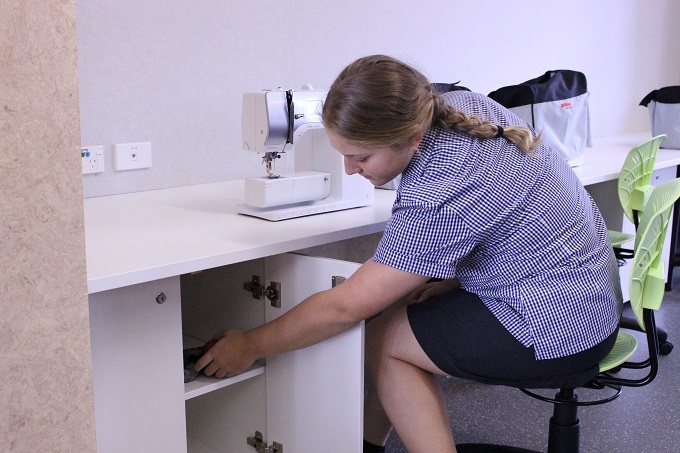
“Many schools buy very expensive electronic machines but the machines I use are all mechanical, not electronic, and very simple. For most school sewing projects the students only need straight stitch, zigzag, some form of stretch stitch and a way of making button holes.
“Mechanical machines take less troubleshooting as most problems arise from either the threading or the bobbin and once you train the kids to deal with that, then the teacher can get on with teaching and not troubleshooting.
“It’s useful to have all the machines the same so that they can share feet; you need an ordinary foot, a zipper foot and some form of buttonhole foot as a minimum. One high school I go to has three generations of one brand and each generation takes different feet!
“As students become more experienced and start to sew knit fabric, access to an overlocker is useful, but this isn’t essential for beginners.
“Sewing machines haven’t actually changed very much through the decades apart from the addition of the automatic threader. I usually end up threading machines for the younger kids. Invariably my younger students pick my older machines to use (Edna is my oldest at about 30 years old) as they are the simplest.
All of the schools I teach in have their machines around the edge of the room on benches. This is a space saving technique as you generally spend the least amount of time at the machine during a lesson. One school has folding desks hinged at the wall which hold one machine, the desk being held up by one leg when raised-personally I think that’s a health and safety nightmare! Also sewing machines are quite heavy. I’d rather they stayed in one place as much as possible.
“Table space is far more important. Tables at the correct height so you can stand or sit at a stool to lay out fabric, draw patterns, and cut. All cutting, pinning, preparation and unpicking should happen at a table, not at the machine. One school I teach at has a mix of high tables and regular ones, whilst the others only have high ones. High is better especially if you have a larger number of students all trying to cut out or pattern draft at once.
“You also need access to ironing boards and irons; I always say that the iron is more important than the sewing machine as it allows for a more professional finish. I spend more time at the ironing board than I do anywhere else in the sewing room. One school I teach in has three three ironing boards which is brilliant.
“Access to sewing tools is important too. clearly labelled and easily accessible storage for scissors (fabric and paper), pins, thread, bobbins, seam rippers etc. And not all in the same place-imagine 30 teenagers all heading for the pins at the same time! Magnetic pin cushions rather than saucers (yes, tea saucers) that I see in some schools.
|
Bullying contributes to poor wellbeing and absenteeism in New Zealand. Discover how you can address…
Free school lunches will continue under a modified model which will reportedly see $107 million…
A new interactive website showing daily attendance figures was launched last week as part of…
Two reviews of early literacy approaches and an accompanying Ministry of Education commentary show promising…
We must have bipartisan decision-making for education, says academics Bronwyn E. Wood and Taylor Hughson…
The OECD’s new report makes several policy recommendations for our education sector in the hopes…
This website uses cookies.